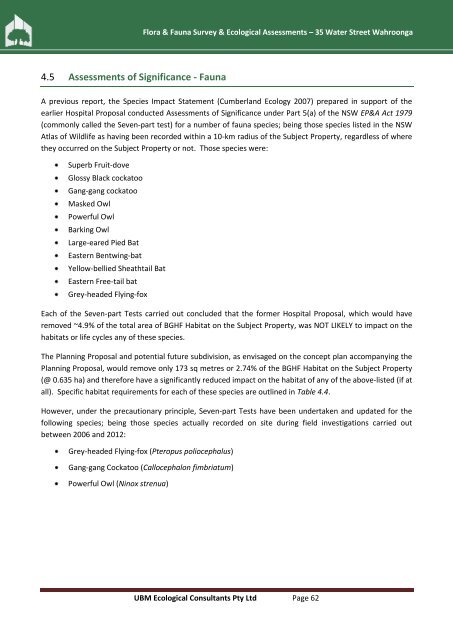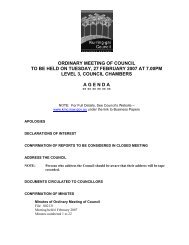Flora & Fauna Survey & Ecological Assessment (pdf. 5MB)
Flora & Fauna Survey & Ecological Assessment (pdf. 5MB)
Flora & Fauna Survey & Ecological Assessment (pdf. 5MB)
You also want an ePaper? Increase the reach of your titles
YUMPU automatically turns print PDFs into web optimized ePapers that Google loves.
<strong>Flora</strong> & <strong>Fauna</strong> <strong>Survey</strong> & <strong>Ecological</strong> <strong>Assessment</strong>s – 35 Water Street Wahroonga<br />
4.5 <strong>Assessment</strong>s of Significance - <strong>Fauna</strong><br />
A previous report, the Species Impact Statement (Cumberland Ecology 2007) prepared in support of the<br />
earlier Hospital Proposal conducted <strong>Assessment</strong>s of Significance under Part 5(a) of the NSW EP&A Act 1979<br />
(commonly called the Seven-part test) for a number of fauna species; being those species listed in the NSW<br />
Atlas of Wildlife as having been recorded within a 10-km radius of the Subject Property, regardless of where<br />
they occurred on the Subject Property or not. Those species were:<br />
Superb Fruit-dove<br />
Glossy Black cockatoo<br />
Gang-gang cockatoo<br />
Masked Owl<br />
Powerful Owl<br />
Barking Owl<br />
Large-eared Pied Bat<br />
Eastern Bentwing-bat<br />
Yellow-bellied Sheathtail Bat<br />
Eastern Free-tail bat<br />
Grey-headed Flying-fox<br />
Each of the Seven-part Tests carried out concluded that the former Hospital Proposal, which would have<br />
removed ~4.9% of the total area of BGHF Habitat on the Subject Property, was NOT LIKELY to impact on the<br />
habitats or life cycles any of these species.<br />
The Planning Proposal and potential future subdivision, as envisaged on the concept plan accompanying the<br />
Planning Proposal, would remove only 173 sq metres or 2.74% of the BGHF Habitat on the Subject Property<br />
(@ 0.635 ha) and therefore have a significantly reduced impact on the habitat of any of the above-listed (if at<br />
all). Specific habitat requirements for each of these species are outlined in Table 4.4.<br />
However, under the precautionary principle, Seven-part Tests have been undertaken and updated for the<br />
following species; being those species actually recorded on site during field investigations carried out<br />
between 2006 and 2012:<br />
Grey-headed Flying-fox (Pteropus poliocephalus)<br />
Gang-gang Cockatoo (Callocephalon fimbriatum)<br />
Powerful Owl (Ninox strenua)<br />
UBM <strong>Ecological</strong> Consultants Pty Ltd Page 62

















